ISSN ONLINE(2320-9801) PRINT (2320-9798)
ISSN ONLINE(2320-9801) PRINT (2320-9798)
Mrs.Maheswari.M1, Ancy.S2, Dr.G.R.Suresh3
|
| Related article at Pubmed, Scholar Google |
Visit for more related articles at International Journal of Innovative Research in Computer and Communication Engineering
Electromagnetic theory says that hertzian waves provide stronger penetrability into objects. Multispectrum illuminator can penetrate tissues at different depths and form images of both surface skin textures and hypodemia. This multi-spectrum sensor provides greater acquisition time and better quality images than any other unimodal sensors. There are many biometric features available like hand, finger, iris, palm etc which are used for various authentication and identification purposes. These features can be captured using various technologies like optical, ultra sound, multispectral and many more. Among all multispectral images have proven for efficient results in both recognition and identification systems. In this paper we will make a study of various multispectral biometric modalities and their acquisition techniques.
Keywords |
| Multispectral, biometric, sensors, spectrum. |
INTRODUCTION |
| The term “Biometrics” is derived from the Greek words bio (life) and metric (to measure).Biometrics is the science of verifying and establishing the identity of an individual through physiological features or behavioural traits. Biometric identifies person based on “what he is” as opposed to “what he knows” (password/PIN) or “what he has” (ID cards). Biometric system utilizes these human traits for authentication or identification purposes [1]. |
| Biometric can be used in positive and negative recognitions. Positive recognition aim to prevent multiple people from using the same identity [2] an example is login using finger print reader in our laptop. Negative recognition is single person having multiple identities. An example is a single person having multiple enrolments. A biometric system is essentially a pattern recognition system that operates in four stages: 1) Data acquisition 2) Signal/Image preprocessing 3) Feature extraction and 4) Feature matching. Biometric characteristics are (1) Universality: Each person should have the characteristics. (2) Distinctiveness: Any two persons should be sufficiently different in terms of the characteristics.(3) Performance: the characteristics should be sufficiently invariant over a period of time. (4) Collectability: The characteristic can be measured quantitatively. |
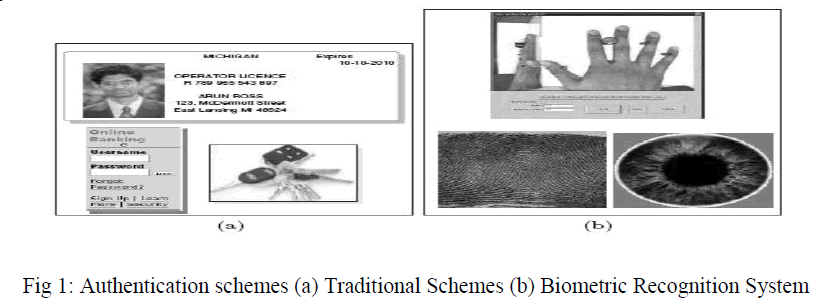 |
| Biometric system can be of Unibiometric or Multibiometric. Unibiometric uses any one of the biometric traits either hand or finger or iris. It has its own limitations like (i) Non-universality (ii) Lack of individuality (iii) Circumvention. In multimodal multiple source of biometric traits are integrated to enhance performance. We use multispectral images to overcome the limitations of unimodal biometric systems. |
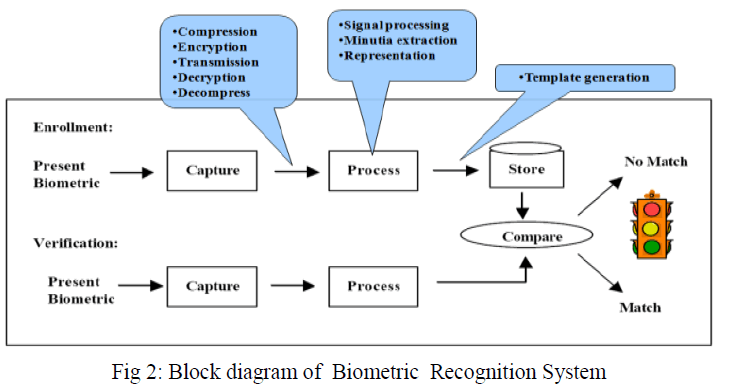 |
| Multispectral images are obtained using multispectral illuminators based on electromagnetic theory. Multispectral methods require different samples of the same object in order to make a better decision. Multispectral image can avoid the metamerism problem of RGB image, at the same time provides more information than just color, and improves the accuracy of the color. It uses various spectrums in the visible range of electromagnetic spectrum. Wavelengths of the illuminator corresponding to the six spectrum are 460nm, 630nm, 700nm, 850nm, 940nm and white light respectively |
 |
BIOMETRIC TECHNOLOGY |
| Biometrics can measure both physiological (active biometric) and behavioural (passive biometric) characteristics. Active or Physiological biometrics (based on measurements and data derived from direct measurement of a part of the human body) include: (1)Finger print (2)Face Recognition (3)Ear Recognition (4)Palm print (5)Vein- Pattern (6)Hand geometry (7)Iris-scan (8)Retina-scan. Behavioural biometrics (based on measurements and data derived from an action) include: (1)Voice-scan (2) Signature-scan (3) Keystroke-scan (4) Gait . |
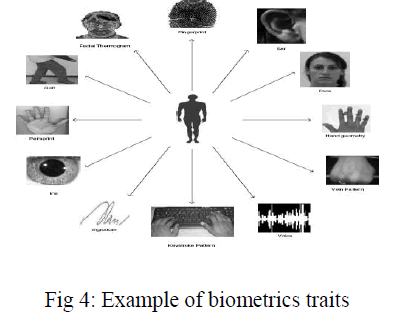 |
MULTISPECTRAL IMAGING |
| Conventional biometrics technologies use either one channel gray level or 3 channel color images. This biometrics may be subject to breach. An example is employing a spoof biometric trait (an artificial or dead finger, or a face mask, for example). Multispectral imaging can help detect breaching of a biometric system. New fingerprint sensors can detect whether the finger placed at the sensor is living or not. Multispectral imaging captures image data at specific wavelengths across the electromagnetic spectrum. This is unlike conventional imaging which captures three channel values: red, green and blue. A gray scale image is a one channel image and an RGB image is a three channel image. A multispectral image is a multichannel (more than three) images which can be seen as a stack of images, each representing the intensity image at a given wavelength (400-1000 nm.). |
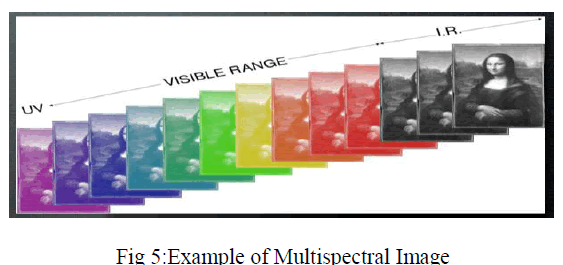 |
FINGERPRINTS |
| Fingerprints are made up of ridges and valleys on the surface of the finger. Segments on the upper skin layer are the ridges and the lower skin layers are valleys. Minutia points are formed by ridges. The fingerprint is determined unique by the pattern of the ridges and minutiae points. A fingerprint pattern can be split into 5 categories: arch, tented arch, left loop, right loop and whorl. |
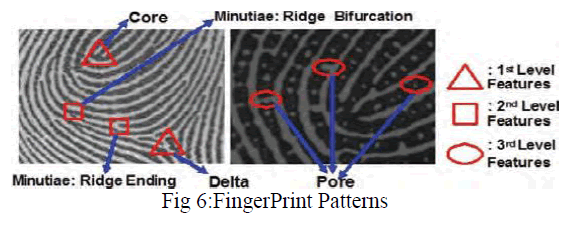 |
| A.MSI Fingerprint |
| MSI sensor captures multiple images of finger under different Illumination conditions that include different wavelengths, different illumination orientations, and different polarization conditions. The output contains information about both the surface and subsurface features of the skin |
| B.MSI Fingerprint Acquisition |
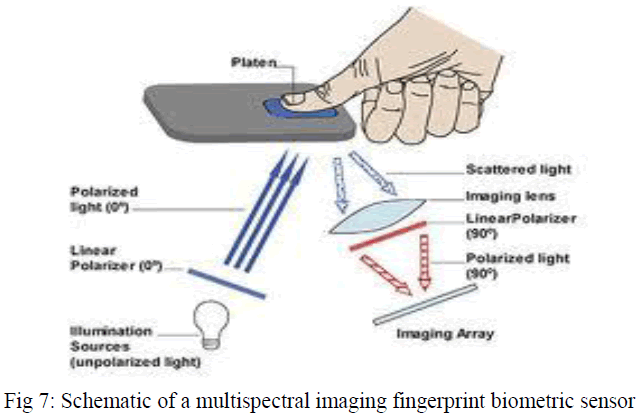 |
| The multispectral sensor consists of two main components: (1)a light source, which provides the light to illuminate the finger resting on a platen; and (2)an imaging system[3], which images this region of the platen onto a digital imaging array. The multispectral sensor is expressly designed to avoid the optical phenomenon of total internal reflectance (TIR) because it depends on clear and complete contact between the fingerprint sensors and the platen to work. |
| MSI sensors typically contain multiple direct-illumination LEDs of different wavelengths. Raw images are captured on a 640 x 480 image array with a pixel resolution of 525 ppi can be combined together to produce a single representation of the fingerprint pattern. All spectral images are fused by using wavelet-based image fusion method. Image fusion occurs by selecting the coefficients with the maximum absolute magnitude in the image at each position[3]. An inverse Wavelet transform is performed on the resulting collection of coefficient yielding a single composite image. |
 |
| C. Fingerprint recognition |
| There are two methods to recognize fingerprints (i)Minutia matching (ii)Pattern matching |
| 1) Minutia Matching |
| The ridges in the fingerprint are compared by unique details. Minutia points are extracted from ridges. They are then compared with a registered template. |
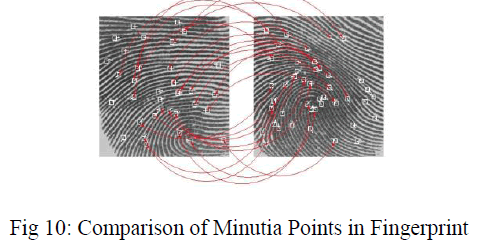 |
| 2) Pattern Matching |
| Pattern based algorithms compare the basic fingerprint patterns (arch, whorl, and loop) between a previously stored template and a candidate fingerprint. In this images are aligned in the same orientation. The algorithm finds a central point in the fingerprint image and centers on that. In a pattern-based algorithm, the template contains the type, size, and orientation of patterns within the aligned fingerprint image [25]. The candidate fingerprint image is graphically compared with the template to determine the degree to which they match. |
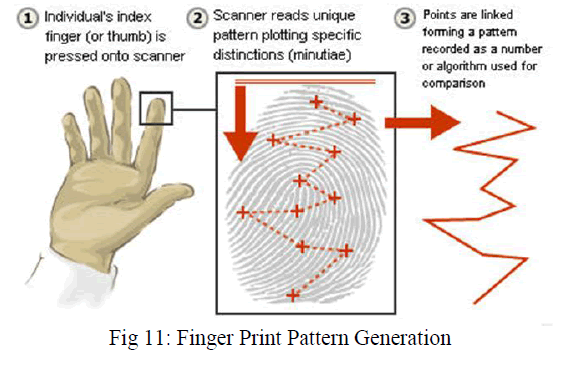 |
| D .Comparison of sensors |
| There are various types of sensors as TIR, MIS etc..These sensors were used to assess biometric performance across all images under six different adverse conditions.(i)Acetone (ii)Chalk (iii)Dirt (iv)Water (v)Low Pressure(vi)Bright ambient. TIR sensors used in the study were: (1) Cross Matcher Verifier 300(Sensor C) (2)Identix DFR 2100(Sensor I) (3) Sagem Morpho MSO 300(Sensor S) |
| 1)Cross Matcher Verifier 300 |
| Cross Matcher Verifier 300(Sensor C) is a single print capture device that delivers accurate and reliable results for identification, verification and registration. |
| 2) Identix DFR 2100 |
| Identix DFR 2100(Sensor I) is a single finger print capture device that provide a large platen, making it more suitable for different size finger. It delivers high performance , both in terms of ease of use and superior image capture, making this readers the perfect choice for all types of large scale finger print programs covering enrollment verification and identification. |
| 3) Sagem Morpho MSO 300 |
| MSO 300 is a single finger print capture device that is more suited for PC environments. It is supported by Morpho KitTM, which include PC software for image capture template processing authentication and identification of maximum of 20,000 people. The two LEDs present in this sensor guide and inform users about on going operations. MSI sensor used in the study is: Lumidigm J110 |
| 4) Lumidigm J110 |
| MSI sensors can capture images over a wide spectral range at a high- dynamic range. For example, an image captured on various spectral ranges such as the visible and infrared (IR) can convey more information about the image than the conventional image sensors. It is designed for most demanding civil and access control applications. J110 delivers high quality finger print images in all environments. It provides clean, clear finger print images when finger are wet, extremely dry or incompletely touching the platen. The size of the data set for each adverse condition was approximately 230 images. The performance of MSI sensor can be better than conventional sensors in both average case and in most specific case. In some cases the performance difference is quite dramatic (e.g. the case of water on the platen). |
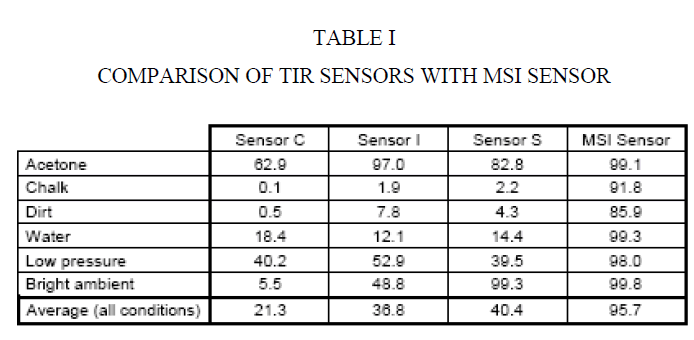 |
| Table 1: Biometrics Performance of each sensor under each adverse condition. Sensor C is a Cross Match Verifier 300,Sensor I is Identifix DFR 2100,Sensor S is Sagem MSO300,and the MSI Sensor is a Lumidigm J110. |
IRIS |
| Iris is a muscle inside the eye that regulates the size of pupil, controlling the amount of light that enters the eye. It is coloured portion of eye with colouring based on the amount of melatonin pigment within muscle. It is unique in every individual ,it remains unchanged till end of life. |
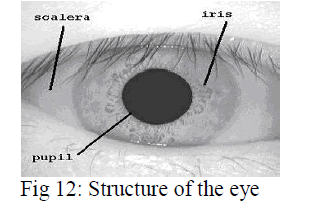 |
| A. Why Iris Recognition |
| Highly protected and stable, template size is small and image encoding and matching is relatively fast. Commercial iris recognition systems operate in the near infrared (NIR) for two primary reasons: |
| 1)The melanin that is responsible for eye coloration is nearly transparent in the NIR, so dark and light eyes present similar albedos in the NIR,simplifying system design |
| (2) The light level required to get good imagery of an iris in t he visible is high enough to be uncomfortable for the subject. |
| B)MSI Iris Acquisition |
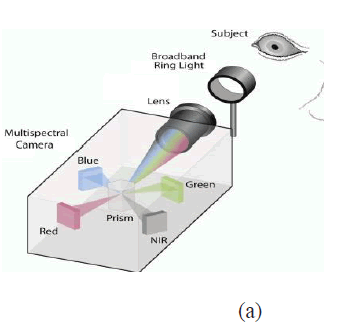 |
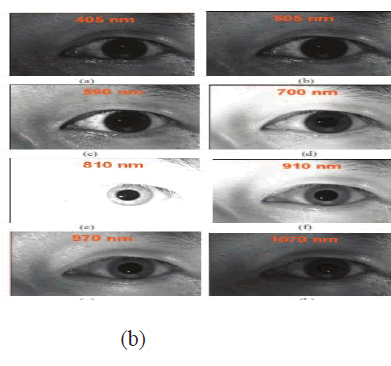 |
| Fig. 13. (a)Multispectral Camera (b) Sample left iris images of a subject captured at wavelengths (a)405 nm, (b) 505 nm, (c) 590 nm, (d) 700 nm, (e) 810 nm, (f) 910 nm, (g)970 nm, and (h) 1070 nm. |
| The multispectral acquisition system shown in Figure 13 (a) utilizes a single-lens camera where four images are simultaneously captured across four different wavelengths by two Sony ICX205AL sensors (with spectral response ranges between 400nm and 1000nm with a peak of 550nm) to capture the IR and red components and two Sony RGBICX205 sensors (blue response ranging from 400nm to 550nm with a peak at 460nm and a green response from 400nm to 650nm with a peak at 550nm) to acquire the green and blue channels. |
| The stereo rig is built from two Hitachi KP-F120 cameras, selected for their sensitivity across the 400nm– 1000nm band. Each camera is equipped with VL-cut filters enabling the selective acquisition of (NIR, NIR), (NIR, VL), and (VL, VL) stereo pairs. Iris specularities are limited to a small portion of the pupil by using a cluster of NIR (750nm–950nm) LED illuminators centered between the cameras together with adaptive illumination which varies in intensity based on ambient lighting conditions. |
| Multispectral iris information to enhance the recognition performance of an iris biometric system. Normal iris recognition systems typically sense the iridal reflection pertaining to the near-infrared (IR) range of the electromagnetic spectrum. The multispectral iris provides information represented in the visible and IR portion of the spectrum. It is hypothesized that, based on the color of the eye, different components of the iris are highlighted at multiple wavelengths [6]. The intricate textural pattern represented in different colored irides is revealed in the ear-IR range and has been traditionally used as a biometric indicator multispectral tries to explore the possibility of eliciting iridal information from the visible and IR ranges of the reflected light. |
| C). Processing and Analysis |
| The contrast and brightness of the images varies with wavelength. These variations can affect the segmentation process of iris recognition algorithms. To avoid this source of variation, we manually segmented the images, setting the scleral region to a uniform gray and the pupil region to black. The manual segmented used a circular model for both the iris and pupil boundaries. Fig. 7 shows the software program we developed to perform this manual iris segmentation step. Iris templates were then generated using a commercial implementation of the Daugman algorithm [5]. The resulting templates were then compared via fractional Hamming distance. The fractional Hamming distance between two iris templates, template A and template B is given by: phase bits A phase bits B mask Bits A mask Bits B mask Bits A mask Bits B HD. The phase bits are the results of the Gabor wavelet decoding of the image. The operator is the Boolean XOR operation to detect disagreement between the pairs of iris codes. Mask A and mask B identify the phase bits that are considered valid and not corrupted by artifacts such as eyelids/eyelashes. The operator is the Boolean AND operator. The operator is used to sum the number of „1âÃâ¬ÃŸ bits within its argument. The fractional Hamming distance is a measure of dis-similarity of two iris images. In many applications, an HD of less than 0.33 can be regarded as a strong indication that the similarity of the underlying images cannot be the result of random chance and that the images therefore are of the same eye. We modified the fractional Hamming distance according to the recipe provided by Daugman to account for variation in the number of valid comparison bits :N where N is the number of bits in the fractional HD calculation. |
 |
| In addition, we threw away all templates with less than 600 valid bits. We label the resulting distance HDâÃâ¬ÃŸÃ¢Ãâ¬ÃŸ in the figures that follow. For this study, the authentic (images are of the same eye) and imposter (images are of different eyes) ground truth was known from the anonymous IDs recorded during the data collection. Hence we can analyze the imposter and authentic distributions as a function of wavelength. Fig. 14 shows the HD for images taken at the same wavelength, averaged over all authentic in the initial data, as a function of the wavelength at which the images were collected. It is likely that eye color, not analyzed as a variable here, is a major contributing factor to the degradation in performance at shorter wavelengths. The degradation at the longer wavelengths is currently a matter for speculation. Both warrant additional investigation. |
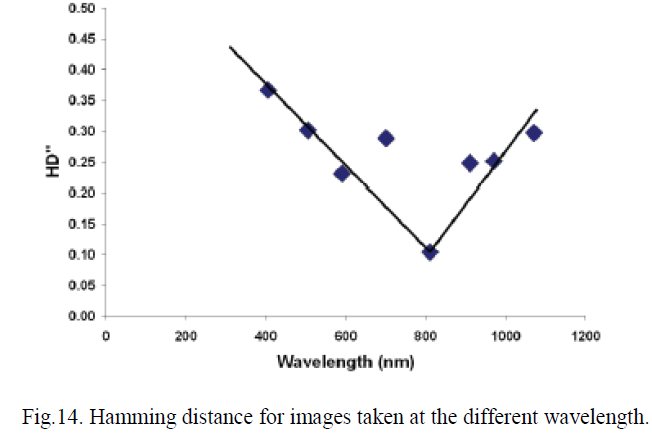 |
| The versatility of iris technology lends itself to virtually any application where identity authentication is required to enhance security, ensure service, eliminate fraud or maximize convenience. |
PALM |
| The palmprint recognition system has many advantages over other biometric systems in respect of reliability, low cost and user friendly. Palmprint is one of the most reliable means in personal identification because of its stability user friendliness, acceptability and uniqueness to avoid spoof attacks and to make it tamper proof, multispectral algorithms can be used to high security zones where vulnerability often happens. In the recent years, a few multispectral palmprint systems have been developed for reliable means of authentication. In this section we briefly describe some well known multispectral palmprint authentication systems. |
| A) MSI Palm Image Acquisition |
| Rowe R.K., et al. 2007[7] proposed a multispectral whole-hand biometric authentication system based on the technology which is used as in the multispectral finger print as discussed above, extending the system to the whole hand. The resulting multispectral data is rich in biometric information providing multiple characteristics of the hand, including: all four fingerprints as well as a partial thumb print, major characteristics of the palm, including principal lines and wrinkles, palm ridges and minutiae, hand shape and skin texture. Each time a hand is placed on the sensor platen (Figure 16 ), a series of six raw multispectral images (MSI) are collected: four images from the four unpolarised direct LEDs in four different orientations, one image collected with the cross-polarized white-light illumination, and one image collected with the TIR illumination. |
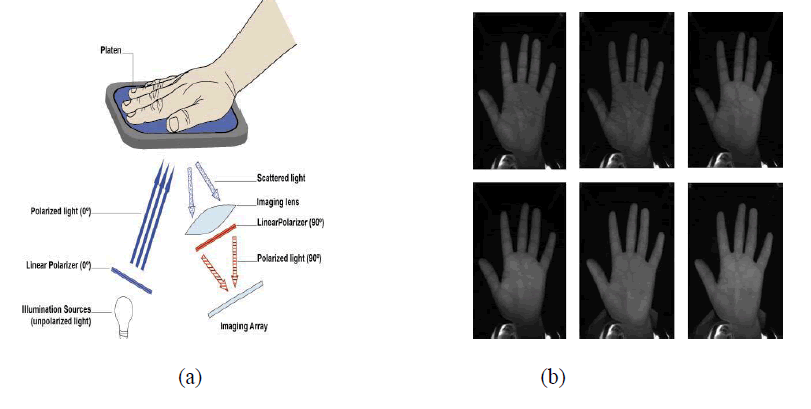 |
| Fig.15. (a) Major optical components and layout of the multispectral whole-hand imaging system. (b)Raw multispectral whole hand images. |
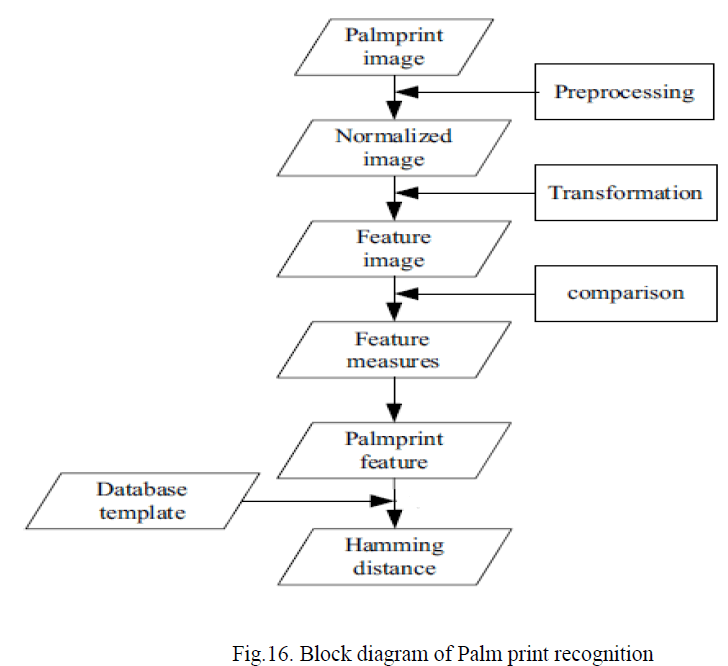 |
| B) Region of Interest |
| After image acquisition preprocessing is done. The preprocessing is used to segment the centre for feature extraction and set up a coordinate system. Pre-processing [7] consists of five steps, 1) binarize the images, 2) boundary extraction, 3) detecting the key points, 4) establish a coordination system and 5) extracting the central part. The image is binarized by Otsu„s [9] thresholding method. The algorithms used for the binarizing and boundary extraction are same but detecting key points [11,12] have tangent based [7], bisector based [16] approaches. Zhong et al. [17] proposed the palmprint image adaptive threshold algorithm, boundary tracking and automatic positioning palm ROI by Euclidean distance, which guarantee the accuracy and efficiency of the identification systems. |
| C) Feature extraction |
| Once the central part is segmented, features can be extracted for matching. The features defined possess the stable and unique properties of low intra-class difference and high inter-class difference. These features are used to create a master template which is stored in the system database. While in Feature matching a matching score is obtained by matching the identification template against the master templates. If the score is less than a given threshold‚ the user is authenticated. Many features of a palmprint can be used to uniquely identify a person. In feature extraction low-resolution palmprint recognition approaches can be broadly classified into three categories: holisticbased, feature- based, and hybrid methods. The holistic-based palmprint recognition approaches use the original palmprint image as a whole to extract holistic features. It can be further divided into subspace-based [12], invariant moment-based [13], and transform-based methods [14]. In feature-based approaches, the local features of palmprint are extracted for efficient palmprint recognition. The palmlines and texture are two classes of stable and distinctive local features. The hybrid approaches use both holistic and local features to improve the recognition accuracy and matching speed. |
| D) Recognition methods |
| In palmprint verification mode the input palmprint image is matched with the palmprint image in the available database. Palmprint matching is based on a normalized hamming distance[9]. It is bitwise operation and uses the XOR operator. The distance is in between range 0 to 1. The hamming distance for perfect matching is zero. To implement a real-time palmprint identification system requires a simple and powerful palmprint matching algorithm. So for the Competitive Code [19] an angular distance is designed for comparing two codes. The distance is between 0 and 1. For perfect matching, the angular distance is zero. In the current systems firstly, the user's palmprint is captured by the system. Then, it is compared to every single image in the database, and a result is produced. This method is very time consuming and computational complexity is also too high to be practical. Palmprint classification provides an important indexing mechanism in a palmprint database. An accurate and consistent classification can greatly reduce palmprint matching time for a large database. Wu et al. [20] proposed the classification of palmprints using principle lines. |
| The algorithm has the ability to classify low-resolution palmprint into six categories according to the number of principal lines and the number of their intersections. These are mainly palms with one principal line, two principal lines without intersection, two principal lines with intersection, three principal lines without intersection, three principal lines of which two intersects and three principal lines of which all lines intersects each other. The proportions of these six categories (1–6) from a 13,800 samples database [20] are 0.36%, 1.23%, 2.83%, 11.81%, 78.12% and 5.65%, respectively. The proposed algorithm is to classify palmprint with an accuracy of 96.03%. If an input palmprint image falls into Category 5, the matching process may still have to search through 78.12% of the original database samples before finding a match. So category 5 is subdivided into 5 subcategories A, B, C, D, E. The result is well-distributed. Among all the samples belong to category 5, 17.6% of them belong to category A, 22.3% of them to category B, 18.3% of them to category C, 23.1% of them to category D, and 18.7% of them to category E. This affirms the effectiveness of the algorithm. In [21] Kumar et al. uses the nearest neighbour (NN) classifier for the classification of extracted feature vectors. The NN classifier is a nonparametric classifier which computes the minimum distance between the feature vector of unknown sample g and that of for gm in the mth class. The class label corresponding to closet training sample is assigned to feature vector g. Three distance measures i.e. L1, L2, Locos are used in [21] to evaluate the performance of feature sets of Gabor, line, PCA. Each of the three feature sets obtained from the three different palmprint representations were experimented with each of the above . three distance measures. The distance measure that achieved best performance was finally selected for the classification of feature sets from the corresponding palmprint representation. K-nearest neighbour is a supervised learning algorithm. The new instance of palmprint is classified on the basis of the majority of K-nearest neighbour category. To find out closest neighbour, calculate angular or hamming distance [22] to each training sample and then sort it in ascending order and then find K nearest training sample. |
| The purpose of this algorithm is to classify a query palmprint image based on attributes and training samples. Given a palmprint image, we find K number of training palmprints closest to the query palm. KNN classifier can be breaking any tie at random. KNN classifier is robust to noisy training data and effective also if data is large. Verification of a query palmprint image is determined by the class of its K-nearest neighbours if class of a query palmprint image is same as output of the K-nearest neighbour classifier, then palmprint is matched with training samples otherwise not matched. In [23] results using the combination HMAX model and support vector machine (SVM) classifier obtains higher recognition rate than those obtained with HMAX model and K-nearest neighbours (KNN) classifier in identity verification system based on palmprint, and also demonstrated that the HMAX model, compared with PCA method, not only obtains higher recognition rate, but also this method is scale and rotate invariant, whereas PCA method provide high recognition rate only in closely controlled conditions. SVM operates on the principle of Structural Risk Minimization (SRM). It constructs a hyper-plane or a set of hyper-planes on a high dimensional space for the classification of input features. The data to be classified by the SVM may not be linearly separable in the original feature space. In the linearly non-separable case the data is projected onto a higher dimensional feature space using Kernel function. Then SVM generates a hyper-plane in H with the decision boundary. SVMs have two basic advantages: First, the kernel techniques can be used to convert nonlinearly separable densities into a pair of linearly separable ones and second SVMs minimize the maximum expected generalization error, leading to good generalization ability. While in [24] the AdaBoost algorithm is used to classify unknown palmprint images. |
| It is a very promising method for invariant palmprint verification. AdaBoost is a very popular boosting algorithm. It assigns each sample of the given training set a weight. All weights are initially set equal, but in every round the weak learner returns a hypothesis and the weights of all examples classified wrong by that hypothesis are increased. Therefore, the weak learner will focus on the difficult samples in the training set. The final hypothesis is a combination of the hypotheses of all rounds and hypotheses with lower classification error have higher weight. |
FACE |
| Multispectral imaging in the visible and near infrared spectra helps reduce color variations in the face due to changes in illumination source types and directions. A novel multi-spectral approach for face recognition using visual imagery as well as the physiological information extracted from thermal facial imagery. Figure 16 illustrates the proposed multispectral face recognition methodology. For each subject in the database, facial images collected simultaneously in the visual and thermal bands |
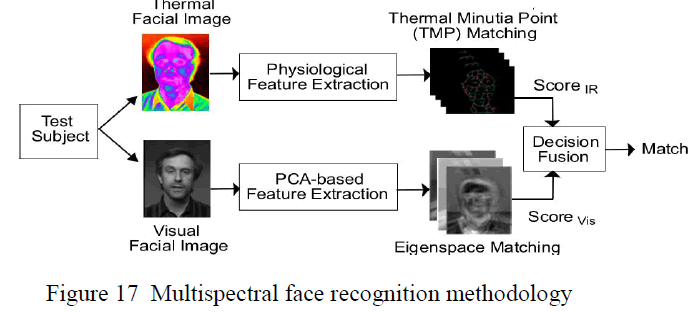 |
| For each of the thermal images, the human face is delineated from the background using the Bayesian framework. The blood vessels present on the segmented facial tissue are extracted using image morphology. The extracted vascular network produces contour shapes that are unique to each individual. The branching points of the skeletonised vascular network, referred to as thermal minutia points (TMPs), are an effective feature abstraction. During the classification stage, the local and global structures of TMPs extracted from the test image are matched with those of the corresponding images in the database. The recognition results from their thermal imaging algorithm are fused with those of a popular visual imaging algorithm. |
| Local binary pattern (LBP) like texture descriptors for efficient multispectral face recognition. They also introduced a simple differential local tertiary pattern (LTP). The claimed that the proposed texture space is less sensitive to noise, illumination change and facial expressions which make it a good candidate for efficient multispectral face recognition. Linear and non linear dimensionality reduction techniques were introduced and used for performance evaluation of multispectral face recognition in the texture space. Their results showed that the use of the proposed texture descriptors permit to achieve high recognition rates in multispectral face recognition. |
CONCLUSIONS |
| Multispectral imaging has been used in many biometrics modalities including fingerprint ,whole hand, iris and vein recognition. It not only increases the effectiveness of the biometrics recognition but facilitates detection of breaching and spoofing. Many commercial biometrics systems based on multispectral imaging available in the industry. However, one type of biometrics is still not 100% strong enough for full proof biometrics system. Multimodal biometrics have been proposed and also in use for more effectiveness. There is still much scope of use and improvement in multispectral imaging. |
References |
|